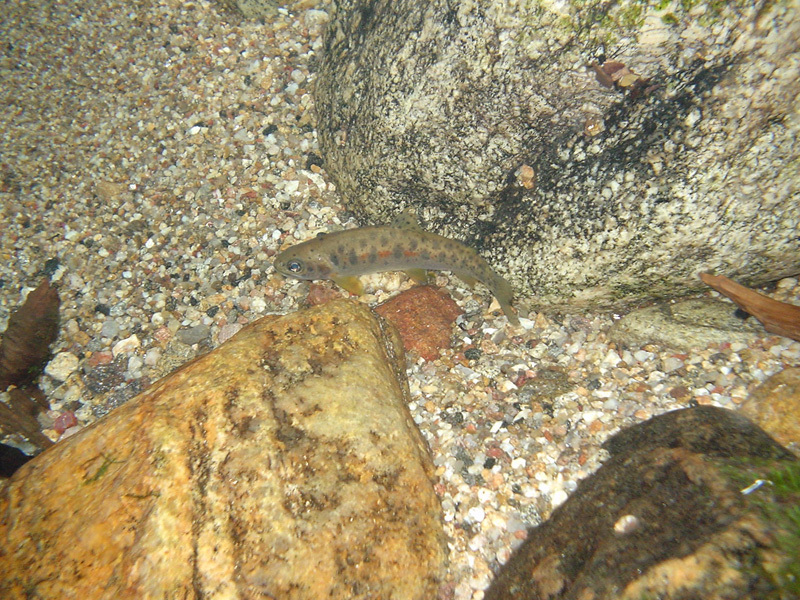
Fish Identification Gallery
“Salmonid” is a term that is inclusive of fish belonging to the extensive family of salmon, trout, char and whitefish.
Below are several of the native and non-native salmonids found in the Pend Oreille Watershed. Click on each picture to see a larger view and click the name below each illustration to learn more about the individual fish including the status, life history, and how to identify the different salmonids.
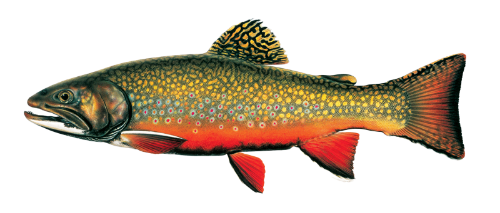
Scientific Name
Salvelinus fontinalis
Identifying Characteristics
Like all salmonids, brook trout have a fleshy adipose fin located between the dorsal fin and caudal fin (tail). Brook trout can be distinguished from other salmonids by the dark vermiculations (wavy lines) on their back, a dorsal fin with black markings, sides having small lateral red spots with blue halos, a nearly squared or slightly forked caudal fin and pectoral, pelvic, and anal fins with white leading edge with an interior black line.
Status
Not native in the Pend Oreille Watershed. Eastern brook trout are classified as a “game species” by WDFW.
Distribution
Eastern brook trout were introduced to the Pend Oreille River and its tributaries via hatchery planting. Intermittent stocking of hatchery brook trout continued into the 1990s (Bennett and Garret as cited in GEI Consultants 2004). Currently, brook trout are abundant and well distributed throughout the Pend Oreille watershed (WCC 2003). Their distribution overlaps throughout much of the historic range of bull trout and westslope cutthroat trout in the watershed, including portions of nearly all spawning and rearing streams (GEI Consultants 2004).
Species Notes
Brook trout are problematic to westslope cutthroat trout due to competition for space and resources, predation risk, and the ability to establish and reproduce quickly. Also as problematic to bull trout, brook trout can hybridize with bull trout creating a sterile offspring. Brook trout has been targeted by the Kalispel tribe of Indians and the Washington Department of Fish and Wildlife for eradication in specific, localized, stream reaches. This is part of a larger objective to reintroduce native westslope cutthroat trout to historically occupied reaches in the Pend Oreille Watershed.
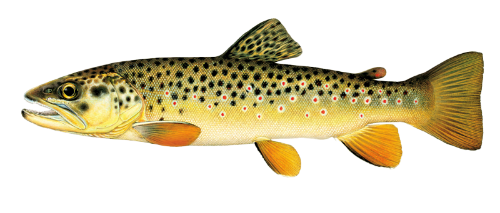
Scientific Name
Salmo trutta
Identifying Characteristics
Like all salmonids, brown trout have a fleshy adipose fin located between the dorsal fin and caudal fin (tail). Commonly, brown trout have a golden brown background color yet this can be less vivid or even nonexistent in some individuals. Brown trout differ from other salmonids, especially trout, by having dark spots on their sides surrounded by pale halos; they can also have red spots with halos but this should not be used as a distinguishing characteristic. Spots on the back can either be irregular or round but lack vermiculations (wavy lines). Brown trout have a squarish tail with or without spots. Brown trout fry are the only salmonid fry with an orange adipose fin.
Status
Not native to the Pend Oreille Watershed. Brown trout are classified as a “game species” by WDFW.
Distribution
Brown trout were introduced to the Pend Oreille River via plantings in the 1890s from an original Scottish strain (Ashe and Scholz as cited in GEI Consultants 2004). Brown trout can be found in the Pend Oreille River and many of the associated tributaries.
Species Notes
Brown trout may be the most common adfluvial salmonid species present in the Pend Oreille River and its tributaries (GEI Consultants 2004). Of all the trout species, brown trout have the ability to withstand and thrive in seasonally warmer water temperatures (Wydoski and Whitney 2003). This species has the capability to thrive in various conditions, grow fast and attain large sizes which likely explains its value as a sport fish.

Scientific Name
Salvelinus confluentus
Identifying Characteristics
Like all salmonids, bull trout have a fleshy adipose fin located between the dorsal fin and caudal fin (tail). The back and sides of bull trout are typically an olive-green/brown color with light cream to crimson colored spots that are similar in size to the pupil of the eye. The belly is often pale yellow or a whitish color. The pectoral, pelvic, and anal fins have a white leading edge and the dorsal fin lacks markings, appearing opaque. Bull trout have a slightly forked caudal fin.
Status
Native to the Pend Oreille Watershed. In 1998, bull trout were listed under ESA as a “threatened” species. The Pend Oreille Salmonid Recovery Team chose bull trout as the number 1 priority fish species for recovery in WRIA 62.
Distribution
Bull trout were historically abundant in the Pend Oreille River (Gilbert and Evermann 1895; WCC 2003). An adfluvial downstream migration pattern is believed to have occurred in the Pend Oreille/Priest River basin in Washington and Idaho. Adult bull trout would migrate out of Lake Pend Oreille, Idaho and then into tributary streams in WRIA 62 to spawn, with the progeny eventually returning to the lake (USFWS 2002). This migration pattern was, however, eliminated with the construction of Albeni Falls Dam in 1952 just upstream of the Idaho-Washington state line (USFWS 2002). Currently, the abundance of bull trout is very low in the Pend Oreille watershed (USFWS 2002, WCC 2003). Bull trout observations in WRIA 62 in the mainstem Pend Oreille River and its tributaries are infrequent and little life history information is known. Bull trout productivity is not well understood, but is also believed to be low. Reproducing bull trout populations still exist in those WRIA 62 tributaries which are part of the Priest River drainage and in the South Fork of the Salmo River (WCC 2003) but are believed to be declining.
Species Notes
Bull trout are extremely sensitive to environmental disturbance (Fraley and Shepard 1989) which makes this an indicator species of environmental change. Several factors are significant to the decline of bull trout populations in the Pend Oreille River in WRIA 62: habitat degradation on the mainstem and within the tributaries; human-made fish passage barriers into tributaries to the Pend Oreille River; non-native fish species introductions and management (eastern brook trout, brown trout, rainbow trout); and the construction and operation of three hydroelectric facilities (Boundary, Box Canyon, and Albeni Falls dams) on the mainstem Pend Oreille River (WCC 2003). Human-caused habitat degradation associated with forest management practices, fire, flood control, livestock grazing, road construction, and land use practices associated with agriculture and residential development have also impacted bull trout in the WRIA (WCC 2003).
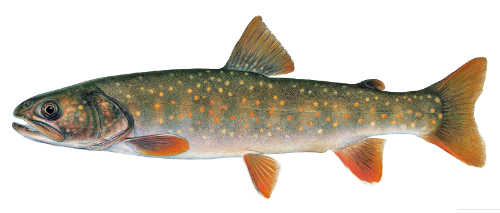
Scientific Name
Salvelinus confluentus
Identifying Characteristics
Like all salmonids, bull trout have a fleshy adipose fin located between the dorsal fin and caudal fin (tail). The back and sides of bull trout are typically an olive-green/brown color with light cream to crimson colored spots that are similar in size to the pupil of the eye. The belly is often pale yellow or a whitish color. The pectoral, pelvic, and anal fins have a white leading edge and the dorsal fin lacks markings, appearing opaque. Bull trout have a slightly forked caudal fin.
Status
Native to the Pend Oreille Watershed. In 1998, bull trout were listed under ESA as a “threatened” species. The Pend Oreille Salmonid Recovery Team chose bull trout as the number 1 priority fish species for recovery in WRIA 62.
Distribution
Bull trout were historically abundant in the Pend Oreille River (Gilbert and Evermann 1895; WCC 2003). An adfluvial downstream migration pattern is believed to have occurred in the Pend Oreille/Priest River basin in Washington and Idaho. Adult bull trout would migrate out of Lake Pend Oreille, Idaho and then into tributary streams in WRIA 62 to spawn, with the progeny eventually returning to the lake (USFWS 2002). This migration pattern was, however, eliminated with the construction of Albeni Falls Dam in 1952 just upstream of the Idaho-Washington state line (USFWS 2002). Currently, the abundance of bull trout is very low in the Pend Oreille watershed (USFWS 2002, WCC 2003). Bull trout observations in WRIA 62 in the mainstem Pend Oreille River and its tributaries are infrequent and little life history information is known. Bull trout productivity is not well understood, but is also believed to be low. Reproducing bull trout populations still exist in those WRIA 62 tributaries which are part of the Priest River drainage and in the South Fork of the Salmo River (WCC 2003) but are believed to be declining.
Species Notes
Bull trout are extremely sensitive to environmental disturbance (Fraley and Shepard 1989) which makes this an indicator species of environmental change. Several factors are significant to the decline of bull trout populations in the Pend Oreille River in WRIA 62: habitat degradation on the mainstem and within the tributaries; human-made fish passage barriers into tributaries to the Pend Oreille River; non-native fish species introductions and management (eastern brook trout, brown trout, rainbow trout); and the construction and operation of three hydroelectric facilities (Boundary, Box Canyon, and Albeni Falls dams) on the mainstem Pend Oreille River (WCC 2003). Human-caused habitat degradation associated with forest management practices, fire, flood control, livestock grazing, road construction, and land use practices associated with agriculture and residential development have also impacted bull trout in the WRIA (WCC 2003).
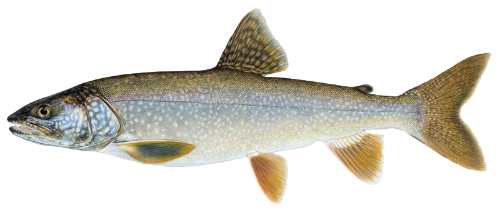
Scientific Name
Salvelinus namaycush
Identifying Characteristics
Like all salmonids, lake trout have a fleshy adipose fin located between the dorsal fin and caudal fin (tail). The body of a lake trout is typically a dark olive background with light colored (whitish) spots that are wavy and irregular in shape, or vermiculations. Lake trout are characterized by a deeply forked caudal fin (tail) and markings on the dorsal fin. Like bull trout, lake trout often have white margins on many of the lower fins. Red or orange spots are not found as in brook and bull trout.
Status
Not native to the Pend Oreille Watershed. Lake trout are classified as a “game species” by WDFW.
Distribution
In 1925, the U.S. Fish Commission first introduced lake trout into Lake Pend Oreille and the Priest Lake system in Idaho (GEI Consultants 2004). Currently, distribution is mainly limited to lakes, but they are occasionally found in the mainstem Pend Oreille River and are believed to be “fall-outs” from Lake Pend Oreille and Priest Lake in Idaho. Abundance, productivity, and genetic diversity are unknown.
Species Notes
Lake trout, as adults, are almost exclusively piscivorous (fish eating) and have the ability to attain large sizes. Due to the impacts on the Kokanee fishery as well as westslope cutthroat trout and bull trout populations, there is currently a $15 per fish bounty on lake trout in Lake Pend Oreille (IDFG). Netting efforts in Lake Pend Oreille and the Priest Lakes have and are continuing to occur to further reduce the abundance of lake trout in these systems.
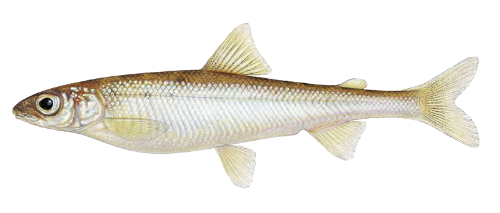
Scientific Name
Prosopium coulteri
Identifying Characteristics
Like all salmonids, pygmy whitefish have a fleshy adipose fin located between the dorsal fin and caudal fin (tail). Their general appearance is silvery or white with an olive-brown back. The snout overhangs the mouth, there is a single flap between the nostrils on each side, the eye is large (similar in diameter to the length of the snout), and the transparent membrane surrounding the eye has a distinct notch below the rear edge of the pupil. The pygmy whitefish differs from the mountain whitefish in dorsal fin ray counts (9–12 vs. 11–15).
Status
Native to the Pend Oreille Watershed. Pygmy whitefish were classified as a “Sensitive” species in Washington State in 1998. The Pend Oreille Salmonid Recovery Team chose pygmy whitefish as the number three priority fish species for recovery in WRIA 62.
Distribution
Historically, pygmy whitefish were found in 15 lakes in Washington, including three in WRIA 62 – Bead, Marshall, and Sullivan (Hallock and Mongillo 1998). Currently, pygmy whitefish are found in just nine Washington lakes, including two in WRIA 62 (Sullivan and Bead). The abundance and productivity of pygmy whitefish in WRIA 62 lakes is unknown (Hallock and Mongillo 1998). The diversity of WRIA 62 populations has been reduced as they are now found in only two of three lakes where they were historically present (Curt Vail, WDFW, pers. comm. 2004).
Species Notes
The future of pygmy whitefish populations is dependent on maintenance of good water quality, spawning habitat, and prevention of predator introductions (Hallock and Mongillo 1998) into Sullivan and Bead lakes.
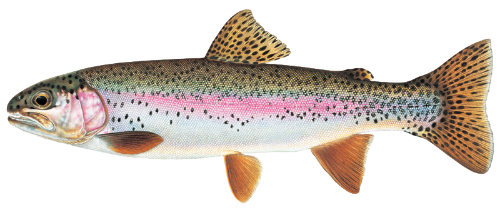
Scientific Name
Oncorhynchus mykiss
Identifying Characteristics
Like all salmonids, rainbow trout have a fleshy adipose fin located between the dorsal fin and caudal fin (tail). Rainbow trout can vary in color but often have a broader distribution of small black spots than most cutthroat. Rainbow trout often have a red or pink band along the midline (side). Rainbows generally lack the red slash marks that cutthroat species have under the jaw line. A faint slash mark has been noted to occur in Columbia River redband rainbow trout, a sub species of rainbow trout. Unlike cutthroat trout (>4” in length), rainbow trout have a maxillary (upper jaw) that does not extend behind the eye. The distinguishing characteristic in rainbow trout is the lack of basibranchial (hyoid) teeth behind the tongue, which are present in cutthroat trout. Due to the potential hybridization between rainbow trout and westslope cutthroat trout, any fish having slash marks and basibranchial teeth behind the tongue should be considered either a hybrid or cutthroat.
Status
Not native to the Pend Oreille Watershed with the exception of anadromous steelhead trout that had historic runs near the Salmo River in Canada. Although not native to the Pend Oreille, rainbow trout are native in eastern Washington, including the Spokane River drainage south of WRIA 62.
Distribution
Rainbow trout (RBT) have been legally stocked in many locations within the Pend Oreille watershed. RBT can be found in Lake Pend Oreille, the Pend Oreille River, and many local lakes and tributaries both connected and disconnected from the main Pend Oreille River system.
Species Notes
Rainbow trout are problematic to westslope cutthroat trout due to competition for space and resources, predation risk, and their ability to hybridize with cutthroat. Currently, there is a bounty for rainbow trout in Lake Pend Oreille.
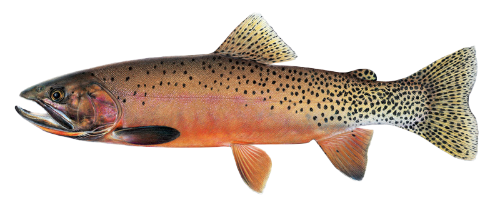
Scientific Name
Oncorhynchus clarki lewisi
Identifying Characteristics
Like all salmonids, westslope cutthroat trout have a fleshy adipose fin located between the dorsal fin and caudal fin (tail). Westslope cutthroat trout also vary in color but have red slashes on the underside of the jaw. The spots are small and irregular and are more concentrated near the caudal fin with few, sparsely distributed spots on the underside of the belly. In fish longer than 4 inches, the maxillary or upper jaw extends beyond the eye. The key characteristic, however, is the presence of basibranchial (hyoid) teeth behind the tongue; rainbow trout lack this feature.
Status
Native to the Pend Oreille Watershed. Westslope cutthroat trout were petitioned in 1998 for listing under ESA as a threatened species. To date, the USFWS has determined that the listing is not warranted. Westslope cutthroat trout are currently designated as a “species of concern” in both Idaho and Washington. The Pend Oreille Salmonid Recovery Team chose westslope cutthroat trout as the number two priority fish species recovery in WRIA 62.
Distribution
Historically, westslope cutthroat trout were abundant in the Pend Oreille River basin (Wydoski and Whitney 2003) and both fluvial and resident forms were believed to be present (USFWS 1999). Westslope cutthroat trout historically occupied greater than 99% of the streams in the Pend Oreille River Basin, which encompasses areas of the Idaho Panhandle and the corner of northeast Washington. Based on surveys, it is believed that westslope cutthroat trout are present in only 35% of their historically occupied stream reaches (KNRD).
Currently, resident westslope cutthroat trout are found in many WRIA 62 tributary streams and adfluvial populations are found in the Sullivan subbasin (Sullivan Lake/Harvey Creek) and those subbasins which drain to Priest Lake (i.e. Hughes Fork, Kalispell, Granite). Abundance is largely unknown (C. Vail, WDFW, pers. comm. 2004), but appears to be dependent upon quality and quantity of habitat and competition from other species (T. Shuhda, USFS, pers. comm. 2004; M. Fairchild, USFS, pers. comm. 2004). Diversity has been reduced from historic levels due to the loss of the fluvial form of cutthroat trout, which are no longer believed to be present in the watershed (C. Vail, WDFW, pers. comm. 2004). Fluvial stocks apparently could not adapt to an adfluvial life history upon construction of dams on the mainstem Pend Oreille River (Scholz 2000 in Wydoski and Whitney 2003).
Species Notes
Factors which have contributed to the decline of westslope cutthroat trout include conversion of the Pend Oreille River from a riverine to a reservoir environment (Wydoski and Whitney 2003) through the construction and operation of three hydroelectric facilities (T. Shuhda, USFS, pers. comm. 2004), displacement from streams by non-native salmonids (T. Andersen, KNRD, pers. comm. 2004), human-made fish passage barriers, and habitat degradation (Wydoski and Whitney 2003) associated with forest management practices, fire, flood control, livestock grazing, road construction, and agriculture (T. Shuhda, USFS, pers. comm. 2004).
Genetic analysis of resident cutthroat trout populations in WRIA 62 has shown that several tributaries support genetically distinct populations of westslope cutthroat trout (Shaklee and Young 2000). However, diversity is limited in some subbasins due to introgression with non-native rainbow trout (M. Fairchild, USFS, pers. comm. 2004).
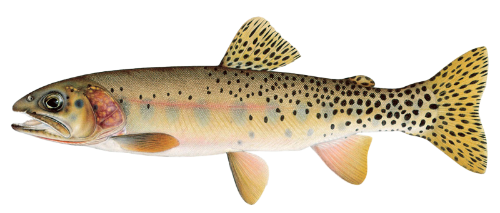
Scientific Name
Oncorhynchus clarki lewisi
Identifying Characteristics
Like all salmonids, westslope cutthroat trout have a fleshy adipose fin located between the dorsal fin and caudal fin (tail). Westslope cutthroat trout also vary in color but have red slashes on the underside of the jaw. The spots are small and irregular and are more concentrated near the caudal fin with few, sparsely distributed spots on the underside of the belly. In fish longer than 4 inches, the maxillary or upper jaw extends beyond the eye. The key characteristic however is the presence of basibranchial (hyoid) teeth behind the tongue; rainbow trout lack this feature.
Status
Native to the Pend Oreille Watershed. Westslope cutthroat trout were petitioned in 1998 for listing under ESA as a threatened species. To date, the USFWS has determined that the listing is not warranted. Westslope cutthroat trout are currently designated as a “species of concern” in both Idaho and Washington. The Pend Oreille Salmonid Recovery Team chose westslope cutthroat trout as the number two priority fish species recovery in WRIA 62.
Distribution
Historically, westslope cutthroat trout were abundant in the Pend Oreille River basin (Wydoski and Whitney 2003) and both fluvial and resident forms were believed to be present (USFWS 1999). Westslope cutthroat trout historically occupied greater than 99% of the streams in the Pend Oreille River Basin, which encompasses areas of the Idaho Panhandle and the corner of northeast Washington. Based on surveys, it is believed that westslope cutthroat trout are present in only 35% of their historically occupied stream reaches (KNRD).
Currently, resident westslope cutthroat trout are found in many WRIA 62 tributary streams and adfluvial populations are found in the Sullivan subbasin (Sullivan Lake/Harvey Creek) and those subbasins which drain to Priest Lake (i.e. Hughes Fork, Kalispell, Granite). Abundance is largely unknown (C. Vail, WDFW, pers. comm. 2004), but appears to be dependent upon quality and quantity of habitat and competition from other species (T. Shuhda, USFS, pers. comm. 2004; M. Fairchild, USFS, pers. comm. 2004). Diversity has been reduced from historic levels due to the loss of the fluvial form of cutthroat trout, which are no longer believed to be present in the watershed (C. Vail, WDFW, pers. comm. 2004). Fluvial stocks apparently could not adapt to an adfluvial life history upon construction of dams on the mainstem Pend Oreille River (Scholz 2000 in Wydoski and Whitney 2003).
Species Notes
Factors which have contributed to the decline of westslope cutthroat trout include conversion of the Pend Oreille River from a riverine to a reservoir environment (Wydoski and Whitney 2003) through the construction and operation of three hydroelectric facilities (T. Shuhda, USFS, pers. comm. 2004), displacement from streams by non-native salmonids (T. Andersen, KNRD, pers. comm. 2004), human-made fish passage barriers, and habitat degradation (Wydoski and Whitney 2003) associated with forest management practices, fire, flood control, livestock grazing, road construction, and agriculture (T. Shuhda, USFS, pers. comm. 2004).
Genetic analysis of resident cutthroat trout populations in WRIA 62 has shown that several tributaries support genetically distinct populations of westslope cutthroat trout (Shaklee and Young 2000). However diversity is limited in some subbasins due to introgression with non-native rainbow trout (M. Fairchild, USFS, pers. comm. 2004).
